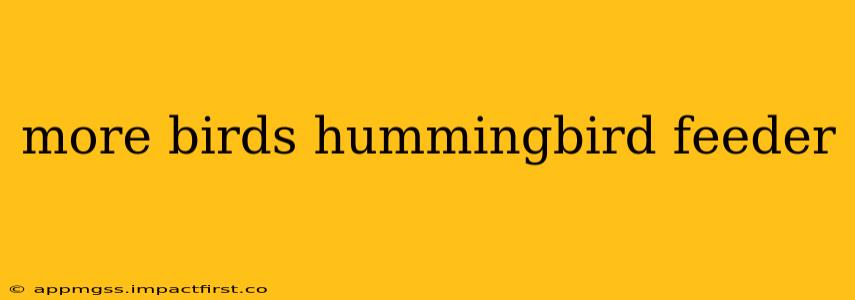Hummingbirds are captivating creatures, their vibrant colors and incredible speed making them a delightful addition to any garden. But attracting these tiny jewels to your feeder requires more than just hanging it up. This comprehensive guide will explore the best strategies to attract more hummingbirds and keep them returning for a nectar-filled feast.
What Attracts Hummingbirds to Feeders?
Hummingbirds are drawn to a variety of factors, and understanding these is crucial for attracting more to your yard. The most important aspects are the type of feeder, the nectar solution, and the surrounding environment. Let's break down each element:
The Type of Feeder:
While various hummingbird feeder designs exist, certain features consistently prove more effective. Look for feeders with:
- Multiple feeding ports: This allows multiple hummingbirds to feed simultaneously, reducing competition and aggression.
- Easy cleaning: Hummingbirds are sensitive to mold and bacteria, so a feeder that's easy to disassemble and clean is crucial for their health.
- Red accents: Hummingbirds are attracted to the color red, so red feeders or red accents on the feeder are highly effective. However, don't rely on artificial coloring in the nectar solution.
- Ant guards: These are vital to keep ants away from the feeder and prevent them from contaminating the nectar.
The Nectar Solution:
The nectar you provide is just as important as the feeder itself. A proper nectar-to-water ratio is key:
- 4 parts water to 1 part sugar: Avoid using honey or artificial sweeteners, as these can harm hummingbirds. Use plain white granulated sugar. Boiling the water before mixing helps to dissolve the sugar completely and also sterilizes the solution.
The Surrounding Environment:
The plants and environment surrounding your feeder play a significant role in attracting hummingbirds.
- Native flowering plants: These provide a natural food source and create a welcoming habitat. Hummingbirds are attracted to tubular flowers, offering easy access to nectar.
- Protection from predators: Provide shelter such as shrubs and trees to offer protection from predators like cats and birds of prey.
- Placement: Hang your feeder in a visible location, away from direct sunlight and excessive wind, but in a place that allows you to easily observe the birds. Consider placing several feeders strategically in different locations within your yard.
How Often Should I Clean My Hummingbird Feeder?
Cleaning your hummingbird feeder regularly is crucial to prevent the growth of mold and bacteria, which can be harmful to hummingbirds. Aim for a cleaning schedule of at least once a week, especially during warm weather. More frequent cleanings are needed during hot or humid periods. Thoroughly scrub all parts with a bottle brush and hot soapy water, rinsing well before refilling.
What Plants Attract Hummingbirds?
Many plants attract hummingbirds, both native and non-native. Research plants native to your region for the best results. Some popular choices include bee balm, salvia, honeysuckle, trumpet vine, and fuchsia.
Why Aren't Hummingbirds Visiting My Feeder?
Several reasons might explain a lack of hummingbird activity at your feeder:
- Poor placement: Ensure your feeder is visible and away from potential dangers.
- Dirty feeder: Clean your feeder thoroughly.
- Poor nectar solution: Use the correct ratio of sugar and water.
- Competition: Other birds or insects might be using the feeder.
- Lack of surrounding vegetation: Provide native flowering plants for additional food sources.
- Predators: Ensure your feeder is located in a relatively safe environment.
By carefully considering these aspects, you can dramatically increase your chances of attracting and keeping more hummingbirds visiting your feeder. Remember, patience is key – it may take some time for hummingbirds to discover your new feeder, especially if you're in a location where hummingbirds aren't abundant. Enjoy the show!
